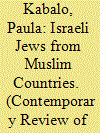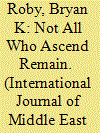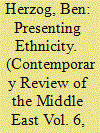| Srl | Item |
| 1 |
ID:
169982


|
|
|
|
|
| Summary/Abstract |
This article sheds light on the salient and far-reaching pattern of association-forming among Jewish immigrants from Muslim countries in Israel during the 1950s and 1960s. They were formally established associations that operated by means of representatives and spokespersons and strove to mediate between the population group that they represented and the state authorities that dealt with immigration and its integration. Interestingly, although few of the members or leaders of these entities have lived under democratic regimes, they established organizations that operated on the basis of democratic principles: election of representatives, holding members’ assemblies, and freedom of expression. They articulated their positions publicly and openly and were not deterred from criticizing policymakers, even those in the highest of echelons.
|
|
|
|
|
|
|
|
|
|
|
|
|
|
|
|
| 2 |
ID:
186577


|
|
|
|
|
| Summary/Abstract |
In the wake of Israeli Black Panther activism in the mid-1970s, the Arab League invited Mizrahi (Afro-Asian) Jews, especially those in Israel, to return to their homeland. Some Israelis used the invitation as an opportunity to highlight the extent of anti-Mizrahi discrimination by departing for the Arab world. Albeit small in number in comparison to those who left Israel for other destinations, those who repatriated made a huge impact on perceptions of Israeli emigres. Their importance rested not in their numbers but in the significant threat posed to the Israeli establishment. Afro-Asian Jewish repatriation sent a message that the Zionist project, particularly as the opposing nationalist movement to Pan-Arabism, was a failure.
|
|
|
|
|
|
|
|
|
|
|
|
|
|
|
|
| 3 |
ID:
169985


|
|
|
|
|
| Summary/Abstract |
In 1950, Israel enacted the Law of Return and 2 years afterwards passed its Citizenship Law. These measures reflected the Zionist goal of encouraging Jewish immigration to Israel/Palestine, so citizenship was mostly limited to Jews. In other words, an ascriptive/ethnic classification was at the foundation of Israeli citizenship. This article explores the construction of the citizenship laws in relation to various forms of categorization—biological descent, cultural belonging, racial classifications, and voluntary affiliation. It asks how the Israeli citizenship policy was presented and which mechanisms were employed in order to justify the incorporation of all Jews, including those from Arab countries, while attempting to exclude non-Jews. After analyzing official state policies and parliamentary debates in Israel regarding the citizenship laws, I present the mechanisms employed to present the ethnic immigration policy. Those mechanisms include emphasizing the positive and democratic sides of allowing Jewish immigration; repeatedly avoiding the usage of racial terminology; highlighting the willingness to incorporate non-Jewish residents; and employing security justifications when prohibiting non-Jewish immigration. Being the Jewish State, Israel wanted to favor Jews in its immigration and naturalization policies. However, being also committed to democratic values and principles, it desired to disassociate itself from racial attitudes.
|
|
|
|
|
|
|
|
|
|
|
|
|
|
|
|